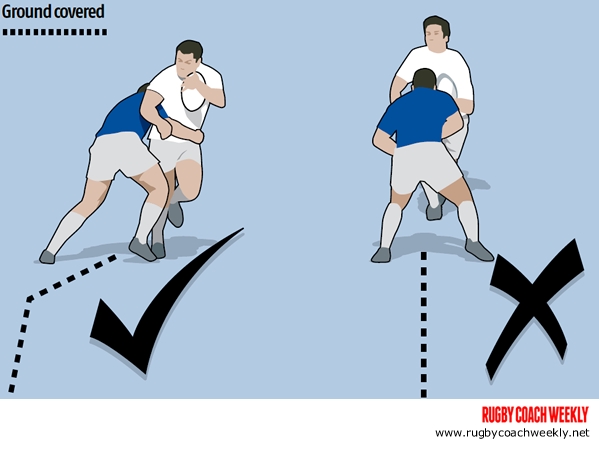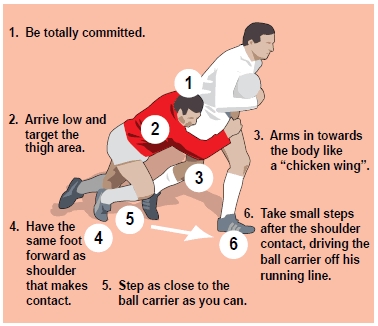Learning to tackle in rugby is crucial for every player. It ensures safety and effectiveness on the field.
Tackling is one of the fundamental skills in rugby that every player must master to play the game well. Whether you are a beginner or an experienced player, understanding the correct techniques is essential. Proper tackling not only helps in winning matches but also prevents injuries.
This blog will guide you through the basics of tackling, from positioning yourself to making the tackle. By the end, you’ll have a clear understanding of how to tackle safely and efficiently in rugby. Let’s dive in and explore the essential techniques you need to know.
Introduction To Rugby Tackling
Tackling is a vital part of rugby. A good tackle can stop an opponent in their tracks and gain an advantage for your team. Understanding the basics of tackling is essential for any rugby player. This section will introduce the importance of tackling in rugby and the basic principles.
Importance Of Tackling
Tackling is crucial for defending in rugby. It helps to:
- Stop the opposing team’s progress.
- Gain possession of the ball.
- Prevent scoring opportunities.
Good tackling can change the game’s momentum. It can inspire your team and demoralize your opponents. Every player should learn to tackle properly.
Basic Principles
Here are the fundamental principles of tackling in rugby:
- Keep your eyes on the target: Focus on the ball carrier’s midsection.
- Get low: Lower your center of gravity. This helps you stay balanced.
- Use your shoulder: Lead with your shoulder to make contact.
- Wrap your arms: Wrap your arms around the opponent to secure the tackle.
- Drive with your legs: Push forward with your legs to bring the opponent down.
Practicing these principles will improve your tackling skills. Remember, safety is paramount. Always use proper technique to avoid injury.
Safety First
Tackling in rugby requires skill and precision. But safety should always be a top priority. Understanding how to tackle safely can prevent injuries and keep the game enjoyable for everyone.
Proper Gear
Wearing the right gear is crucial. A well-fitted mouthguard protects your teeth and jaw. Padded clothing, like shoulder pads, can absorb impact. Headgear can protect your head from minor injuries. Make sure your gear is in good condition and fits properly.
Injury Prevention
Warm up before playing to prepare your muscles. Stretching helps to avoid strains. Learn the correct technique for tackling. Keep your head up and use your shoulder, not your head, to make contact. Stay aware of your surroundings to avoid collisions. Practice tackling drills to improve your form and confidence.
Stance And Positioning
In rugby, mastering the correct stance and positioning is crucial. It helps you tackle effectively and safely. A good stance ensures you are ready for action. Proper positioning allows you to anticipate your opponent’s moves. This section covers the basics of stance and positioning in rugby.
Optimal Stance
Stand with your feet shoulder-width apart. This gives you a strong base. Bend your knees slightly. Keep your back straight. Your head should be up and eyes forward. This helps you see the field. Arms should be ready to move. This stance prepares you for quick actions.
Maintaining Balance
Balance is key in rugby. Keep your weight on the balls of your feet. This keeps you agile. Avoid leaning too far forward or backward. This prevents you from losing balance. Keep your center of gravity low. It helps you stay grounded. Stay relaxed but alert. This balance helps you tackle effectively.
Tackling Techniques
Learning how to tackle in rugby is essential for any player. Proper tackling techniques can prevent injuries and improve your overall performance. This section will cover two key tackling methods: front-on tackles and side tackles.
Front-on Tackles
Front-on tackles are direct and forceful. Start by positioning your body in front of the opponent. Keep your knees bent and your weight balanced. Aim to hit the opponent below the chest. Wrap your arms around their legs or waist. Drive them backward using your shoulder and leg strength. Ensure your head is to the side to avoid injury.
Side Tackles
Side tackles are used when approaching the opponent from an angle. Position yourself slightly to the side of the opponent. Keep your knees bent and stay low. Aim to hit the opponent around the waist or thighs. Wrap your arms around their legs firmly. Use your shoulder to drive them sideways or backward. Keep your head to the side to stay safe.
Effective Training Drills
Effective training drills are essential for mastering the art of tackling in rugby. These drills help players build strength, improve technique, and boost confidence on the field. By practicing specific drills, players can enhance their tackling skills and reduce the risk of injury. Below are some effective training drills that can help players at all levels.
Partner Drills
Partner drills involve working with another player to practice tackling techniques. These drills help players learn how to tackle in a controlled environment.
- One-on-One Tackling: Players take turns tackling each other. This helps improve timing and positioning.
- Wrap and Roll: One player tackles while the other player practices rolling away. This drill enhances agility and control.
- Tackle Bags: Use tackle bags for safe practice. One player holds the bag while the other tackles it. This helps build strength and technique.
Solo Drills
Solo drills allow players to practice tackling techniques on their own. These drills focus on individual skills and conditioning.
- Shadow Tackling: Players practice tackling movements without a partner. This helps improve footwork and positioning.
- Dummy Tackling: Use a tackling dummy to simulate an opponent. This drill helps build confidence and technique.
- Footwork Drills: Practice quick foot movements. This helps with agility and positioning during a tackle.

Credit: www.wikihow.com
Reading Opponents
Understanding how to read your opponents is crucial in rugby. It can make the difference between a successful tackle and a missed opportunity. By developing the ability to predict and react to your opponent’s moves, you can improve your defensive game.
Predicting Moves
Predicting an opponent’s moves requires careful observation and anticipation. Focus on the player’s body language and positioning. Experienced players often give subtle hints about their next move.
- Watch their eyes: Players often look where they intend to go.
- Observe their hips: The direction of their hips can indicate their next move.
- Notice their speed: A change in pace can signal a sudden move.
Consistent practice in reading these cues will improve your ability to predict and counter your opponent’s actions.
Reacting Quickly
Quick reactions are vital for effective tackling. Once you predict a move, react instantly. A delayed response can give the opponent an advantage.
- Stay low: A low stance helps you move quickly and maintain balance.
- Keep your eyes on the target: Focus on the player’s torso to avoid being misled by feints.
- Engage: Commit to the tackle with confidence and determination.
Training drills can help enhance your reaction time. Practice with teammates to simulate real-game scenarios.
Common Mistakes
Learning how to tackle in rugby is essential for every player. But many players make common mistakes that can lead to penalties or even injuries. Understanding these mistakes can improve your game significantly.
Avoiding High Tackles
A high tackle is a common mistake in rugby. It occurs when the tackler’s arm makes contact with the opponent’s neck or head. This type of tackle is dangerous and often results in penalties.
- Focus on the opponent’s waist.
- Keep your body low.
- Wrap your arms around the player’s legs.
By targeting the waist or lower, you can avoid high tackles and keep the game safe.
Preventing Penalties
Penalties can cost your team points and momentum. Common mistakes that lead to penalties include:
- Not releasing the tackled player.
- Playing the ball on the ground.
- Tackling an opponent without the ball.
To prevent penalties, follow these rules:
- Release the player immediately after the tackle.
- Stand up before playing the ball.
- Ensure the opponent has the ball before tackling.
Adhering to these guidelines will help you avoid penalties and keep the game fair.

Credit: www.youtube.com
Building Confidence
Confidence is crucial in rugby, especially for tackling. A confident player can make a big difference on the field. Building confidence involves mental preparation and consistent practice. Let’s explore how to achieve this.
Mental Preparation
Mental preparation is key to building confidence in tackling. Visualize successful tackles. Picture yourself making strong, effective tackles. This mental imagery helps build self-belief.
Positive affirmations also help. Tell yourself you are strong and capable. Repeat these affirmations daily. They reinforce your confidence.
Stay calm under pressure. Deep breathing exercises help manage stress. Practice these techniques to keep your mind clear during the game.
Consistent Practice
Consistent practice is essential for building confidence. Practice tackling drills regularly. Repetition helps you master the technique.
Work on strength and conditioning. Strong muscles support effective tackling. Regular fitness training boosts your physical readiness.
Practice with teammates. Collaborative drills improve your tackling skills and build trust. Communication during practice enhances coordination and confidence.
Keep track of your progress. Note improvements and areas needing work. This tracking helps you stay focused and motivated.
| Practice Element | Frequency | Benefits |
|---|---|---|
| Visualize Tackles | Daily | Boosts self-belief |
| Positive Affirmations | Daily | Reinforces confidence |
| Deep Breathing | Before Games | Manages stress |
| Tackling Drills | Weekly | Masters technique |
| Strength Training | Weekly | Boosts physical readiness |
| Team Drills | Weekly | Improves coordination |

Credit: www.rugbycoachweekly.net
Frequently Asked Questions
What Is The Proper Way To Tackle In Rugby?
The proper way to tackle in rugby involves using your shoulder, keeping your head to the side, and wrapping your arms around the opponent.
How Can I Improve My Tackling Skills?
Improve your tackling skills by practicing regularly, focusing on technique, and strengthening your core muscles for stability and power.
Are There Any Tackling Safety Tips?
Yes, always keep your head up, use your shoulder, and avoid high tackles to prevent injuries during a rugby game.
What Are Common Tackling Mistakes In Rugby?
Common tackling mistakes include tackling too high, not wrapping your arms, and leading with your head, which can cause injuries.
Conclusion
Mastering rugby tackles is crucial for playing well. Practice consistently. Focus on technique. Maintain a low center of gravity. Use your shoulders, not your head. Stay confident and alert. Tackle safely. Keep improving your skills. Enjoy the game and its challenges.
With dedication, you’ll become a better player. Happy tackling!


